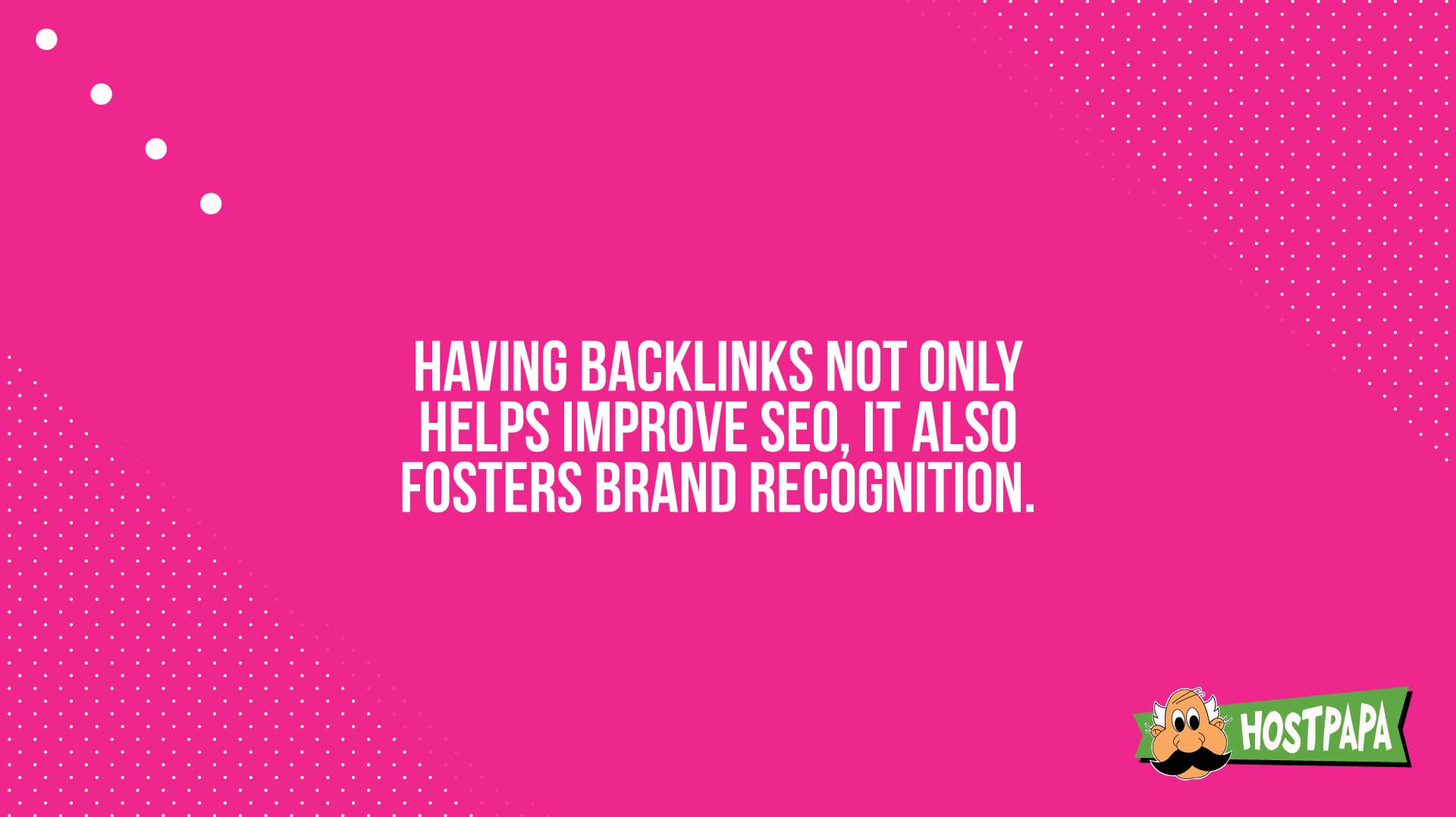Publishing fresh, high-quality content is still the number one way to boost your site’s SEO.
The second-most important factor is a great link network.
A site with many links from high-authority domains will rank higher than one with fewer backlinks or links from less relevant sites.
In this article, we’ll cover precisely what backlinks are, discuss how they impact SEO, and explain how you can build an effective link network.
Let’s get the ball rolling briefly at backlinks and why they matter to your website.
- What Are Backlinks?
- Why Are Backlinks Important?
- What Kind of Backlinks are Valuable?
- How Backlinks Impact the SEO Strategy
- Creating Content Worth Linking To
- Finding Sites to Bring Incoming Links to Your Site
- Tips for Effective Backlink Strategies
What Are Backlinks?
Backlinks are links between websites. They’re also called inbound links or incoming links.
If another website links to yours, you have a backlink. If your site includes an external link, that’s a backlink for the target site.
Backlinks play a significant part in how search engines rank your site. Not all links will positively impact your ranking. Those that do will be from websites people trust, which mostly have high domain authority.
Having high-quality backlinks not only helps improve your SEO but also fosters brand recognition.
Links in a blog post stand out, and some people hover over them before they even read the post for the reader, which creates an association between your brand and the post’s topic.
Backlinks allow you to reach people who may not otherwise be aware of your business or blog. They can help establish relationships with your audience and attract new followers.
Building a backlink network is easy. There are only two steps:
- Create high-quality content worth linking to.
- Research potential websites for backlinks and contact them.
Both those link-building steps come with challenges. Creating high-quality content requires domain knowledge and creativity. Doing keyword research for potential link-building can be time-consuming.
We’re going to delve into both those areas, but first, let’s take a quick look at how important a quality link network can be to your site’s SEO.

Why Are Backlinks Important?
In the vast realm of digital marketing, a powerful strategy has remained steadfast in its effectiveness over time – the art of link-building through backlinks. In essence, backlinks are hyperlinks that lead back to your website from other sites.
They play a vital role in search engine optimization (SEO) by signalling to search engines that your website is a trustworthy and authoritative source of information, which can result in higher rankings in search engine results pages (SERPs).
So, why are backlinks important? To answer that question, let’s start with how search engines work.
Search engines use complex algorithms to crawl and index the vast amount of content on the internet. When a user types a query into a search engine, the algorithm analyzes the website content across the internet to determine which sites are most relevant to the user’s search.
One of the ways search engines determine relevance is through backlinks. When a website links to another website, it’s like giving a vote of confidence that the linked site is a trustworthy and authoritative source of information.
The more high-quality backlinks a website has, the more likely it is to rank higher in search results.
What Kind of Backlinks are Valuable?
However, not all backlinks are created equal. Search engines consider the quality of the linking site when evaluating the credibility of the linked site.
A backlink from a well-established and respected website, such as a government website or a widely recognized news outlet, carries more weight than one from a small, unknown website. Additionally, the relevance of the linking sites to the content of the linked site is also considered by search engines. It’s considered more valuable than the ones from sites with unrelated content.
The idea is that when websites link to relevant and credible sources, they offer their audience more value, resulting in a better user experience.

How Backlinks Impact the SEO Strategy
Backlinks serve as endorsements. They’re subtle indications that the person or company linking their web page to your site approves your blog or business.
Your target audience will be impressed by this endorsement, and while that contributes to the value of backlinks, your site visitors aren’t the only ones who notice. Search engines see backlinks too.
Backlinks tell Google that others approve of your content. When its algorithms assess the number and quality of sites that link to yours – a high number indicates that your content has value, so it should get a higher ranking in search results.
But the number of sites linking to yours is only one example of how backlinks impact SEO. Here’s a list of how Google analyzes your backlinks and uses the information to determine your ranking.
- Age: The longer a backlink has been around, the better. Google will rank your site higher if your backlinks are older, while newly created backlinks will be considered less valuable.
- Authority: When a linking site has a very high ranking in search results, that backlink is perceived as having a higher value than one from a site that appears buried in search results.
- Relevancy: A backlink from a site doing something similar to yours has a more positive impact on ranking than a link unrelated to your niche. This relevancy analysis extends down to the page level.
- Diversity: Are all your backlinks from blog posts? A disproportionate number of backlinks from a single source warns Google that your links may not be organic. The search engine favours a natural link profile with backlinks from various source types.
- Context: Backlinks appearing in a page’s content will do more for your ranking than elsewhere, like in the sidebar or footer. Even the location within the content is essential. For example, a backlink at the beginning of a blog article is seen by Google as better than one that shows up at the end.
- Content Length & Quality: Backlinks from a long blog post—anything over 1000 words – will significantly impact SEO more than a link from a short blurb. Content quality matters too. Backlinks from content that’s full of spelling errors or is unoriginal will not help your ranking as much as links from high-quality content.
As you can see, Google uses sophisticated algorithms to analyze your backlinks to determine where your site will be in search results.
Now, we’ll discuss how to build a link network that will help your SEO. As we run down the necessary steps, remember how search engines can reward and punish a site based on its backlinks.
Creating Content Worth Linking To
The better your content is, the more backlinks you’ll be able to earn.
A referring site vouches for your business or blog by linking to you. The last thing they want is to send their trusting audience to a site with lousy content.
That’s why the referring site owner will scrutinize your content when you ask for a backlink. A link will be given only if your content meets their standards.
In this section, we’ll look at some ways you can ensure that your content passes the test.
Reach New Heights with Skyscraper Content
There are probably keyword searches that return links to your competitor’s content—content with tons of valuable backlinks.
Those should be your backlinks.
One way to make that a reality is by publishing skyscraper content. It’s content that improves on the coverage provided by existing content to such an extent that it gets ranked higher than what it was modelled after.

Here are the steps for creating skyscraper content:
Find Content on Your Topic That Has a Lot of Backlinks
A Google search will take care of this – simply search using your keyword. All the results on the first page will have plenty of backlinks.
Write a Better Version of the Content You Found
How much better? This strategy is most effective if your content is 5-10 times better. If you look closely and get creative, you will find ways to convey the information more effectively.
Maybe you find an article that’s well-written but stops short of covering the whole topic. Perhaps it also lacks pictures and external links.
In that case, you can create a better article on the same topic in three ways. If you add the missing information, include helpful images or an infographic, and add some links to helpful external resources, your coverage of the topic will be better.
Get the Backlinks That Now Rightly Belong to You
Point a backlink tool at the content you improved on. Backlink Checker from Ahrefs would be a good choice. You’ll get a list of sites that link to the content.
Reach out to all those sites and inform them of your superior version. It will speak for itself, compelling that they should link to your content instead.
With skyscraper content, you’ll get more traffic to your business website or blog. Plus, there’s a significant bonus – it’s traffic that your competitors won’t get. Search results, and eventually backlinks, will direct people to your content instead of your competitors.
That’s business. You’re all vying for the same audience, so what may seem like an aggressive tactic is quite necessary.
Go With High-Value Formats
A lot of content gets ignored, but there are some types that, regardless of the subject matter, receive more attention than others.
Regular blog articles perform OK, but the following formats tend to blow them away in terms of views:
- List articles
- Quizzes
- “How to” articles
- Infographics
- Videos
This doesn’t mean you should focus exclusively on those formats; including content using one or more styles is a good idea.
A backlink to an infographic, in particular, can have a very positive impact on your SEO. They’re incredibly effective at increasing traffic to your site, partly because they’re easy to view, understand, and share.
You’ll need to ensure that the data contained in the infographic is relevant, but when you hit just the right level of detail on a topic your audience is interested in, you’ll see just how effective the format can be.
Keep an Eye on the Competition
Some site owners spend the time and effort needed to create what they believe will be highly valuable content, only to find that no one will link to it.
A trial-and-error approach to content marketing and link-building strategy is a nonstarter for a small business or blog with limited resources. It makes more sense to get it right the first time.
One way to do that is to find out what “right” is, which can be accomplished before creating a single piece of content.
Watch what your competitors are doing.
Create alerts so you’ll be notified as soon as they publish new content. Follow them on social media. Subscribe to their newsletters.
If they’re getting more backlinks than you are, analyze their marketing strategies. Do what they’re doing.
One great tool for keeping tabs on your competitors’ backlinks is Monitor Backlinks. You simply input your biggest rivals’ URLs, then sit back and wait for a weekly report detailing all new backlinks they’ve earned. If you include your own site, the report will be an effective tool to monitor the success of your backlink efforts.
Once you see exactly what’s getting your competitors more backlinks than you, you can reproduce aspects of their approach and start to level the playing field.

Finding Sites to Bring Incoming Links to Your Site
There was a time when, if you had content on a site that linked back to yours, that would improve your ranking. It could be any site—a relevant connection to your blog or business was not a factor. There were plenty of article submission sites and blog networks to meet everyone’s backlink needs.
That shotgun approach to link building won’t cut it anymore.
Google’s search algorithms were updated to punish sites that engage in spam link-building. The artificial link-building techniques that worked beautifully in the past will now push your site to the 10th page of search results.
All that means is site owners need to get a little more creative when finding backlink opportunities.
In this section, we’ll go over some ways you can find sites that will link to yours, focusing on backlink quality over quantity.
Building Relationships With Other Websites
One of the easiest ways to get other sites to link to yours is to ask other website owners.
It’s usually that simple!
But who should you ask? To answer that, it’s back to Google. Search for blogs or other sites that publish a weekly or monthly digest, roundup, or newsletter with updates about your field.
Use your keyword plus “roundup,” for example, and cherry-pick sites with the most current and consistently published content. Those are the sites you’ll want to reach out to.
Email the site owners or webmasters, introduce yourself and your site, and provide a link to your best content. A percentage of those you contact will find your content useful, and they’ll link to it in their next post.

Publish Guest Articles
When you write an article that will be published on another website, that’s at least one backlink in the bag. After all, you control what’s in the post, so you can include multiple links to precisely the parts of your site that you want to highlight.
Backlinks aside, guest posts are also a great way to gain exposure to a new audience, bolster your reputation as a leader in your field, and expand your social media following.
When it’s time to find a site willing to publish your guest article, there are several ways to go about it:
- Search for blogs that accept guest posts. Construct search strings that include your keyword, plus “guest posts,” “bloggers wanted,” or “contribute,” for example. The results can point you in the right direction.
- Research blog writers that have the most influence. See if you can contribute to the same sites they post on.
- Check social media. Search Twitter or Facebook using the same kinds of search strings mentioned above.
When you write a guest article, in addition to a backlink that will direct the reader to your site, also include links to your social media profiles. You can give people multiple ways to stay current with your business or blog, so make the most of it.
Scan Your Site for Broken Links
Broken links are a gold mine for earning backlinks.
The first step of this technique is to find relevant sites related to your niche. Sites that include a Resources page are prime targets. Search using your keyword, plus the word “links” or “resources.”
Once you’ve found a few sites, use a tool like Check My Links to find any broken links. If one of the broken links is to content like yours, you’ve hit pay dirt.
All left to do is reach out to the site owner with a friendly email reporting the broken link. That’s your opportunity to suggest a link to your content as part of the fix.
A gentle approach is recommended. Explain that their site links to a resource that’s no longer available. In addition to your link, include a few other options when suggesting a replacement. This will sell the idea you’re trying to help, not just begging for a backlink.
Sweeten the Deal with a Testimonial
With this topic; you may notice a trend. Many of the best ways to get more backlinks to your site are to provide something to the linking site and then ask for a backlink. Writing a testimonial is an excellent example of that approach.
There are probably high-authority sites you use when you’re running your business or blog. If a leading site in your field is a valuable resource to you, there’s a very good chance your audience knows about it too.
Any association between that kind of site and yours would positively impact SEO and get you more referral traffic. If you’re going to go to the trouble of writing a testimonial, make it for a site like that.
A glowing testimonial is valuable. Providing one to a handful of high-profile sites related to your business or blog will earn you at least a couple of backlinks. Plus, they’ll be some of your highest-value backlinks because of the increased exposure you’ll gain by associating your site with a major player.
Transform Linkless Mentions into Backlinks
Ah, the unlinked mention – it’s genuinely the low-hanging fruit of link-building.
When your blog or business gets mentioned in an article, but the reference doesn’t actually link to your site, that’s an easy target for requesting a backlink.
What makes this approach so easy? You already have your foot in the door. The person who published the content knows who you are and thinks enough of your blog or business to have mentioned you.
A friendly email with the suggested URL will almost always get a positive response: a new backlink for your site.
Tips for Effective Backlink Strategies
In this section, we’ll explore some tips to ensure your backlink strategy is effective and delivers the desired results. Here are some top tips for optimizing your backlink strategy:
How to Disavow Low-Quality Backlinks
When it comes to backlinks, quality is always better than quantity. If you have backlinks from low-quality or spammy websites, they can negatively impact your website’s SEO efforts. To disavow these links, you can use Google’s disavow tool. This tool tells Google to ignore these links when crawling your website, which can help improve your website’s overall SEO.
Monitor and Disavow Low-Quality Backlinks
To keep your backlink portfolio healthy and high-quality, it’s essential to monitor your backlinks regularly. Use tools like Google Search Console or Ahrefs to identify low-quality or spammy backlinks. Once identified, use the disavow tool to remove these links from your portfolio.
Diversify Your Backlink Portfolio
Having a diverse range of backlinks from different types of websites can help increase the credibility and authority of your website. Aim to obtain these backlinks from various sources, including high-authority websites, social media platforms, and niche directories. By diversifying your backlink portfolio, you’ll not only improve your website’s SEO, but you’ll also future-proof your backlink strategy against algorithm updates.
Why Diversification Is Important
Diversification is critical in backlinking because it helps mitigate the risk of having all your backlinks come from one source. If a particular website or directory that you rely on for backlinks suddenly becomes obsolete or loses its authority, your website’s SEO efforts could suffer. By diversifying your backlink portfolio, you ensure your website has a wide range of high-quality backlinks relevant to your niche.
Following these tips for effective backlink strategies can improve your website’s SEO and drive more traffic. Building quality backlinks takes time and effort, but the results are well worth it in the long run.
Conclusion: Quality Backlinks Lead to Increased Site Performance
A great link network is critical to improving your SEO and increasing traffic. Sites with many links from respected domains outperform those without them.
In this blog, we explored what backlinks are and how to get them for your website. We also discussed the importance of backlinks for SEO and shared some effective backlink strategies to help improve your website’s search engine ranking. We offered suggestions about creating link-worthy content and getting site owners to add your backlink.
If you apply the suggested techniques, you should see an improvement in your site’s ranking in search results over time, and remember that it’s an ongoing process that needs time to complete. That will mean more traffic to your site and more blog readers, followers, subscribers, prospects, and customers.
Have you enjoyed this post? Hop over to the HostPapa blog to read more articles like this one!







